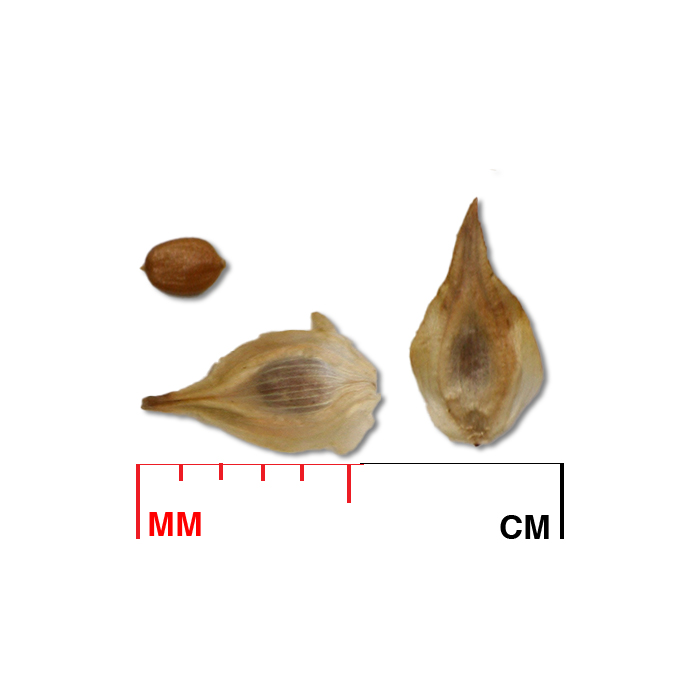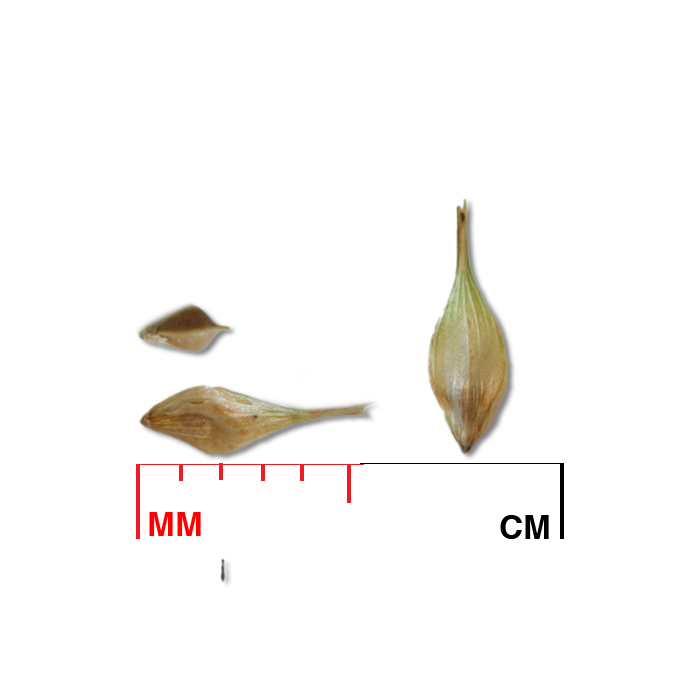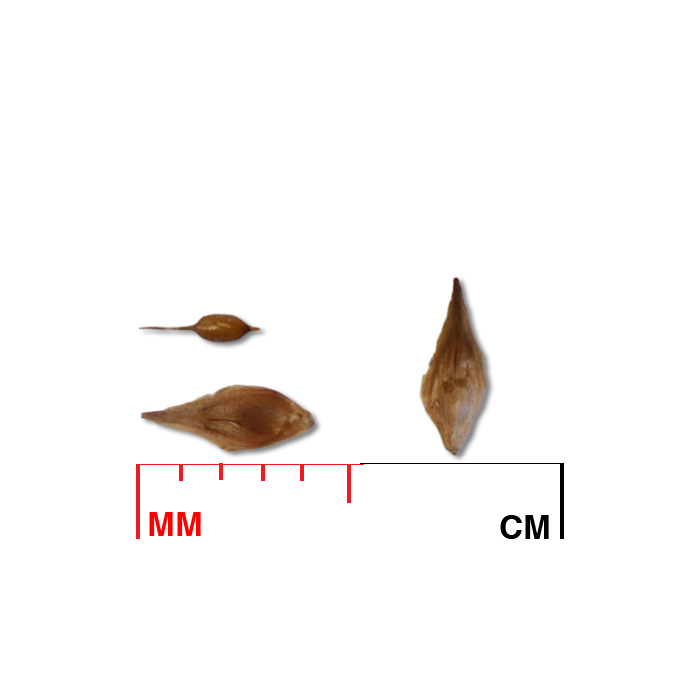Sedges
Sedges sagemThe Species Production Guides for sedges and rushes provide specific information about growing each of these species for seed production.
Scroll the list (alphabetized by scientific name) or press ctrl-f (or command-f) to search for any name in this page.
A printable file (pdf) is also provided on each completed species page for those needing a print version.
This section is a work in progress. We will continue to add new species guides as they are completed. At this time, one upland, one obligate wetland, and one facultative wetland species are complete. Propagation of other species in those categories is similar, except for the rhizomatous ones. The methods used for Carex bicknellii, for example, can be applied to other tufted, upland species such as C. brevior and C. molesta.
Carex annectens / yellowfruit sedge
Carex bebbii / Bebb's sedge
Carex brevior / shortbeak sedge
Carex cristatella / crested sedge
Carex gravida / heavy sedge
Carex interior / inland sedge
- Carex laeviconica / smoothcone sedge
Carex molesta / troublesome sedge
Carex pellita / woolly sedge
Carex sartwellii / Sartwell's sedge
Carex stricta / upright sedge
Carex suberecta / prairie straw sedge
Carex tribuloides / blunt broom sedge
Carex vulpinoidea / fox sedge
Scirpus atrovirens / green bulrush
Scirpus cyperinus / woolgrass
Bicknell's sedge
Bicknell's sedge dickeye
Carex bicknellii Britton
Alternate Common Names: Bicknell’s oval sedge, copper-shouldered oval sedge
Scientific Synonyms: Carex bicknellii Britton var. bicknellii, Carex brevior. (Dewey) Mack var. crawei (W. Boott) B. Boivin, Carex straminea var. crawei Boott, Carex straminea Willd. var. meadii Boott
Family: sedge family (Cyperaceae)
Functional Group: sedges and rushes
Description
- Life cycle and growth form
perennial, short black rhizomes, forms bunches
Height: 1-4 ft
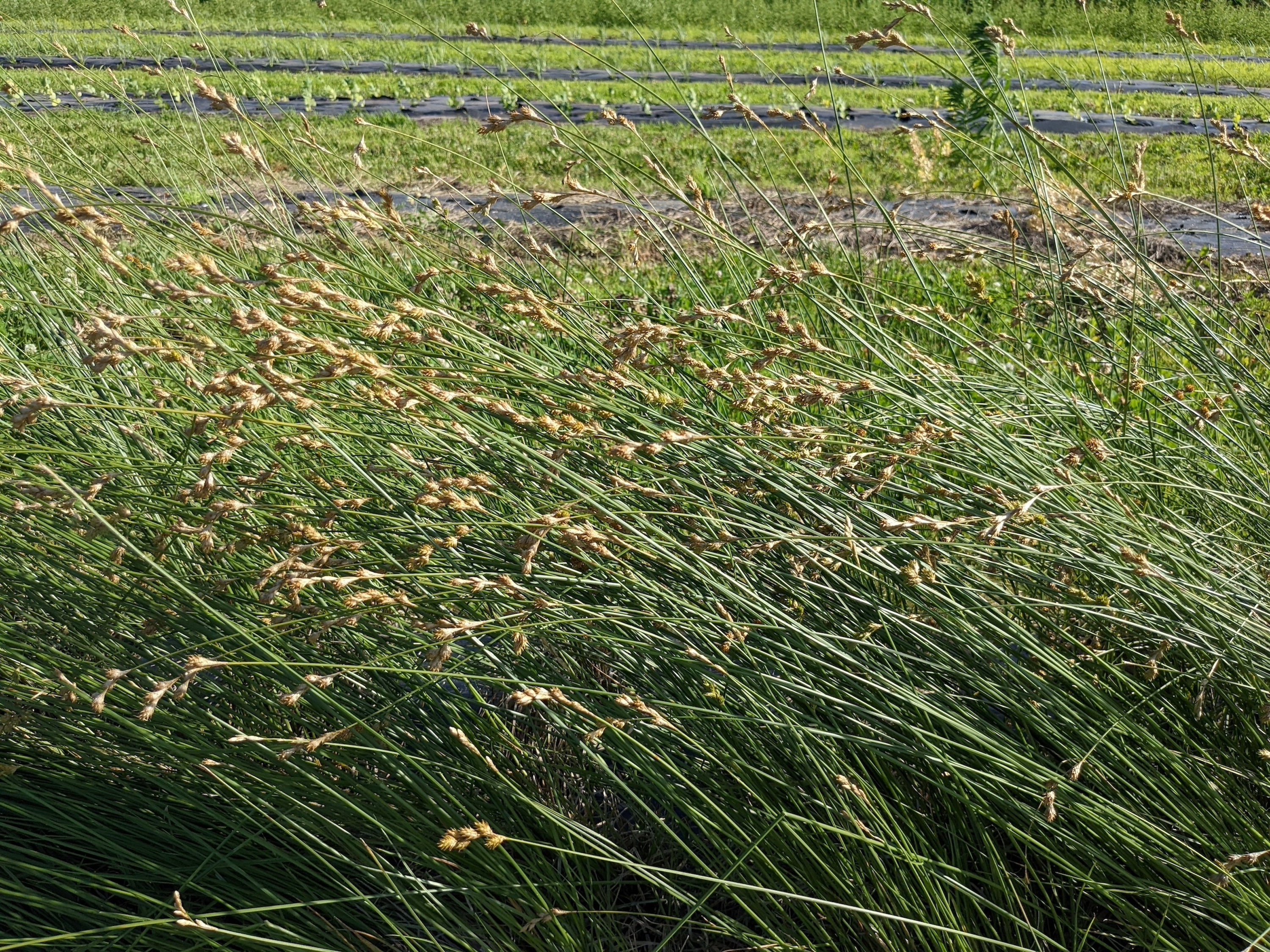
- Leaves and stem
3-4 leaves per stem, alternate, three-ranked, rough margins, pale green, flat and thin
- Flower, fruit and seedhead
Flower/fruit/seedhead: Erect to arching seed heads 2-6 cm long; 3-6 oval spikes with cone-shaped bases, each 10-18 mm long, per stem.
Pollination: wind
- Seed
Seed characteristics
Seed weight:
Seeds per ounce: 17,000 seeds/oz (IA NRCS)
1000 seed weight: 1.31g (Seed Information Database)
Description: Achene broadly elliptical, brown; mature perigynium (sac-like structure around the achene) flattened, with a translucent and membranous wing, distinct, parallel veins, and coppery-brown “shoulders,” the source of one alternate common name, “copper-shouldered oval sedge.”
Typical seed test
PLS: 84% (n = 11)
Purity: 98% (n = 10)
Germination: 30% (n = 7)
Dormancy: 61% (n = 7)
(averages obtained from n tests of purchased seed lots)
- Habitat and range
Habitat: Dry to moist soil; full sun; prairies, rock outcrops, savannas, along railroads; Wetland Indicator Status is Facultative Upland (FACU) for the Midwest.
Conservation status: Global- G5, secure; Delaware- SX, presumed extirpated; Vermont- SH, possibly extirpated; Arkansas, Maine, New Hampshire, Pennsylvania, and South Carolina- S1, critically imperiled; Massachusetts- S1/S2, critically imperiled to imperiled; New Jersey and Ohio- S2, imperiled (NatureServe)
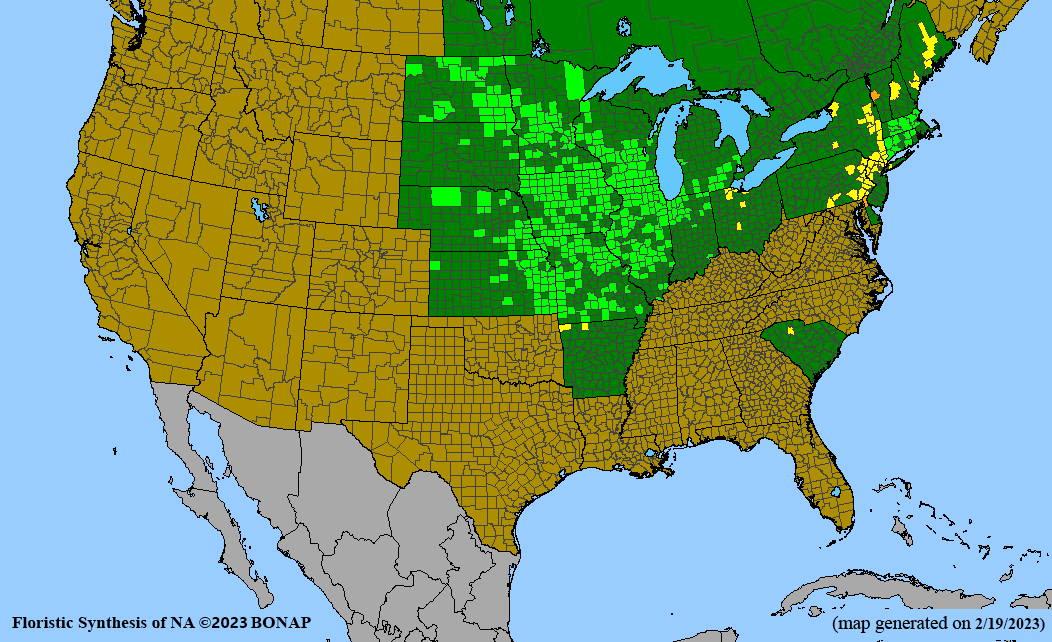
General Comments
Sedges are a large, diverse group of grass-like plants that are important components of prairies, wetlands, and woodlands across our region. In Iowa alone, there are about 120 species of sedges. Grasshoppers and the larvae of skipper butterflies, among other insects, feed on sedge foliage, and their seeds are eaten by grassland birds. They are notoriously difficult to identify to species, especially the oval sedges to which Bicknell’s sedge belongs. The development of stock seed by the Tallgrass Prairie Center in the early 2000s enabled broader access to reliably identified sedge species by native seed growers. The large, winged perigynia of Carex bicknellii, with their pearly color and translucence, make this species somewhat easier to identify than other oval sedges. This species is also one of a few oval sedges that are commonly found in upland prairie habitats. Seed production plots of Carex bicknellii in mesic to dry mesic soils do not require irrigation.
Recommendations for Seed Production
- Establishment for seed production
Direct seeding
Not recommended for this species.
Greenhouse
Seed pre-treatment: 30 days cold-moist stratification; removal of perigynia produces a similar effect as stratification on germination in this species.
Sowing: Sow in germination flats or directly into plugs (2-3 seeds per cell), covering seed lightly (light improves germination of many sedge species); maintain even moisture until germination. Daytime temperatures should be around 70-80°F (22-27°C) and allowed to drop at night to 50-60°F (10-15°C). We have had good success planting into 2.5 in deep, 73-cell plug flats that are ridged to direct root development downward and have 3/4 in bottom openings to encourage root pruning and the formation of firmly rooted plugs for transplanting.
Transplanting: Seedlings are ready to transplant to the field about 10 weeks after sowing. Pop out a few plugs to check for adequate root development that will provide sturdy plugs for planting. A week or two before transplanting, move flats outside to ‘harden off.’
- Stand management
Weeds: Plastic mulch reduces weed pressure in the first year or more. Holes in the plastic should be widened somewhat in subsequent years to allow the bunches to expand. The most significant weed issue can be the presence of other oval sedges such as Carex brevior and Carex molesta, since they are competitive and their seed is difficult to distinguish from Carex bicknellii in the field and practically impossible to clean out of harvested seed. Obtaining clean, reliably identified, certified stock seed helps to prevent this issue.
Pests: None noted.
Diseases: None noted.
- Seed production
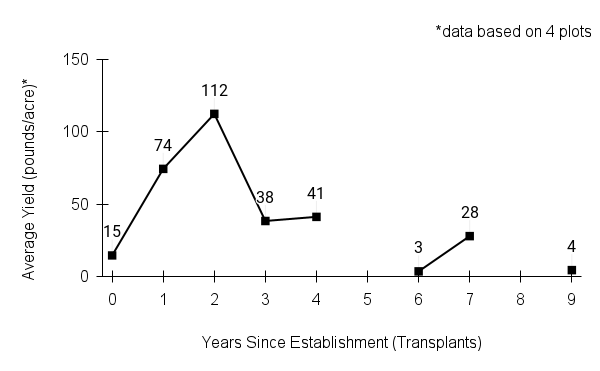
First harvest: There may be a small amount of seed in the first season, but most plants begin flowering and producing seed in their second growing season after transplanting.
Yield: Peak harvests are in the second through fourth years after transplanting, with yields from 40-112 pounds per acre, extrapolated from harvests of four plots grown at the Tallgrass Prairie Center.
Stand life: Plants may persist for up to ten years or more, but productive stand life is about five years, after which our yields have declined.
Flowering date: June in northeast Iowa
Seed maturity: Mid-late June to early July
Seed retention: Significant shattering occurs in high winds when perigynia are mature; lodging can also occur due to heavy rains/storms, complicating combine harvest.
Harvest date range at TPC (2007-2023): June 14 - July 31
Recommended harvest method: Combine when mature; a good rule of thumb is to wait until about 10% of seed heads have begun shattering.
- Seed cleaning and storage
Cleaning process: Air-dry seed for two weeks or more after harvest. Pass material through a coarse screen (1/2 in hardware cloth) to remove larger stemmy material, if needed, then air screen. If perigynia removal is desired, pass material through a brush machine with medium bristles before air screening. (Note: perigynia removal destroys several characteristics used in identification.)
Seed storage: cool/dry (33-50° F, 30-50% RH)
Released Germplasm
Source Identified material: Natural Selections/Iowa Ecotype Zone 1 (northern IA) and Zone 2 (central IA)
- References
Boeck Crew, C.M., Myers, M.C., Sherrard, M.E., Elgersma, K.J., Houseal, G.A., & Smith D.D. (2020). Stratification and perigynia removal improve total germination and germination speed in 3 upland prairie sedge species. Native Plants Journal, 21(2), 120-131. https://doi.org/10.3368/npj.21.2.120
Chayka, Katy. (n.d.). Carex bicknellii (Bicknell’s sedge). Minnesota Wildflowers. https://www.minnesotawildflowers.info/grass-sedge-rush/bicknells-sedge
Cochrane, T. S., Elliot, K., & Lipke, C. S. (2014). Bicknell’s Sedge. In Prairie Plants of the University of Wisconsin-Madison Arboretum (3rd ed., p. 160). University of Wisconsin-Madison Arboretum.
Hilty, J. (2019). Bicknell’s sedge - Carex bicknellii. Illinois Wildflowers. https://www.illinoiswildflowers.info/grasses/plants/bicknell_sedge.htm
Houseal, G. (2010). Plasticulture for seed production of wetland (Carex) species. Native Plants Journal, 11(1), 58-64. https://doi.org/10.2979/NPJ.2010.11.1.58
Mastrogiuseppe, J., Rothrock, P. E., Dibble, A. C., & Reznicek, A. A. (2020, November 5). Carex bicknellii Britton. Flora of North America. http://floranorthamerica.org/Carex_bicknellii
Mohlenbrock, R. H. (1999). Carex bicknellii. In Illustrated Flora of Illinois - Sedges: Carex (p. 139). Southern Illinois University Press.
Murphy, M. & Spyreas, G. & Marcum, P. (2025) Carex of Illinois & Surrounding States: The Oval Sedges. University of Illinois Press
NatureServe. 2024. NatureServe Network Biodiversity Location Data accessed through NatureServe Explorer [web application]. NatureServe, Arlington, Virginia. Available https://explorer.natureserve.org/. (Accessed: February 28, 2024).
Schütz, W. & Rave, G. (1999). The effect of cold stratification and light on the seed germination of temperate sedges (Carex) from various habitats and implications for regenerative strategies. Plant Ecology 144, 215–230. https://doi.org/10.1023/A:1009892004730
USDA NRCS National Plant Data Team. (n.d.). Carex bicknellii Britton. USDA plants database. https://plants.usda.gov/home/plantProfile?symbol=CABI3
Species Guide Updated 2/5/2025
Buxbaum's sedge
Buxbaum's sedge dickeye
Carex buxbaumii, Wahlenb.
Alternate Common Name: brown bog sedge
Scientific Synonym(s): Carex buxbaumii var. anticostensis Raymond, Carex holmiana, Carex polygama Mackenzie
Family: sedge family (Cyperaceae)
Functional Group: sedges and rushes
Description
- Life cycle and growth form
Perennial, long-rhizomatous, forming large stands with a distinctive bluish-green color compared with the yellow-green of most sedges.
Height: 1-2.5 ft
- Leaves and stem
Leaves flat, hairless, and rough on the edges; lower sheaths are rusty brown and ladder fibrillose (made of evenly spaced, linked fibers) near their tops, flowering stems are stiff and 3-sided, smooth.
- Flower, fruit and seedhead
Fruit/seedhead: 1-4 spikes per plant; pistillate spikes bear up to 40 perigynia per spike, distinctive scales are red-purple to dark brown with a green midvein, perigynia (papery coverings around each “seed”) are hairless and gray-green, can be beakless or have a tiny beak, “seeds” (achenes) are 3-sided.
Pollination: wind
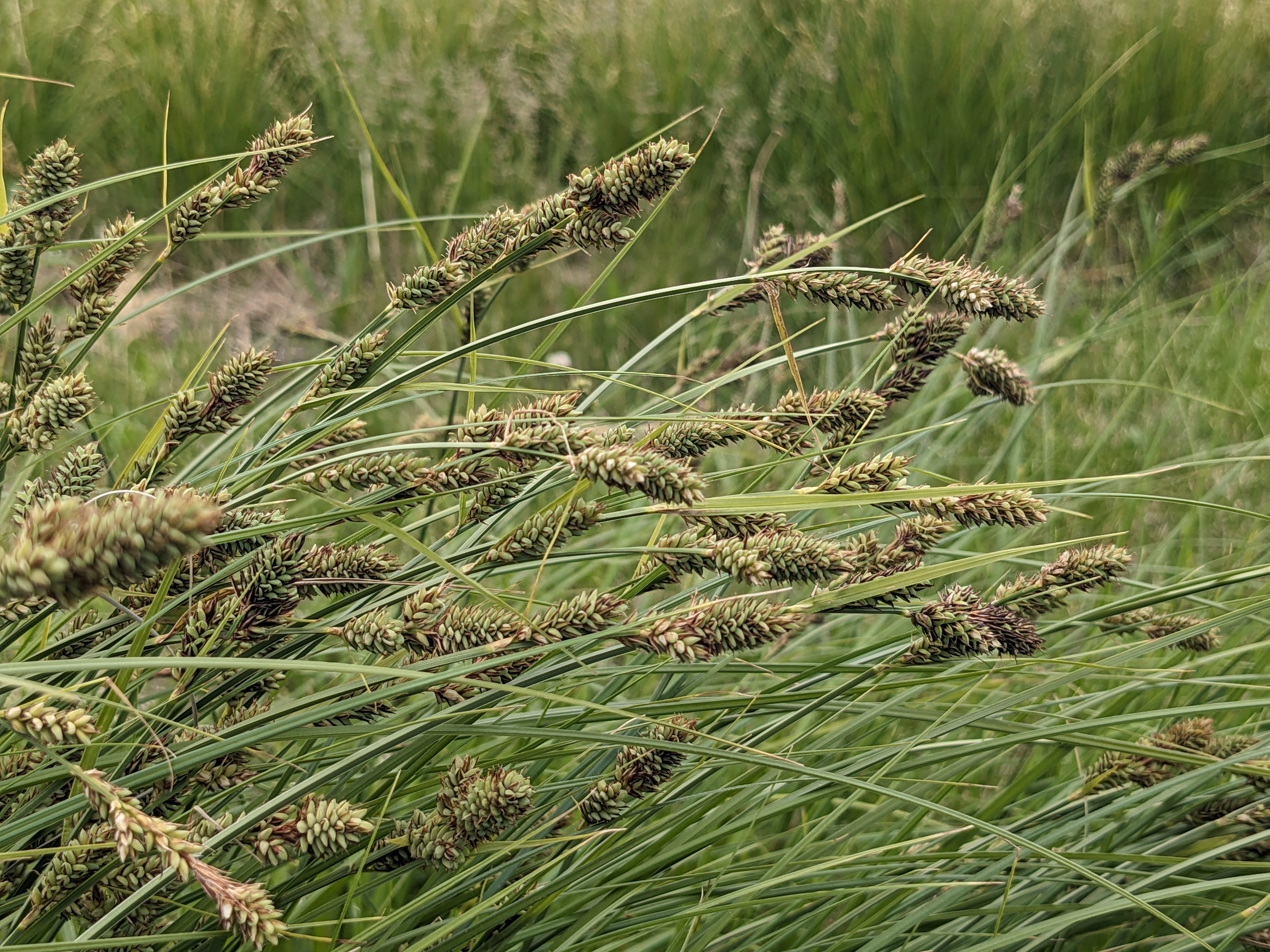
- Seed
Seed characteristics
Seed weight:
Seeds per ounce: 14,500 (IA NRCS)
1000 seed weight: 1.66 g (Seed Information Database)
Description: Seed unit is an achene (2 mm long) with surrounding perigynium (1.5 x 3 mm); perigynia are gray-green with lighter veins and a very short beak; achene is three-sided and brown.
Typical seed test
unknown at this time.
- Habitat and range
Habitat: Mesic to wet soil; partial to full sun; prairie swales, meadows, fens, marshes, ditches; Wetland Indicator Status is Obligate Wetland (OBL) for the Midwest; irrigation is recommended for seed production.
Conservation status: Global- G5, secure; District of Columbia and Georgia- SH, possibly extirpated; Arkansas, Connecticut, Delaware, Kansas, Kentucky, New Hampshire, South Carolina, South Dakota, Tennessee, and Vermont- S1, critically imperiled; Maryland, Missouri, Nebraska, Nevada, Massachusetts, New York, North Carolina, North Dakota, Virginia, and West Virginia- S2, imperiled; California, Idaho, New Jersey, Pennsylvania, Washington, Wyoming, and Illinois- S3, vulnerable (NatureServe)
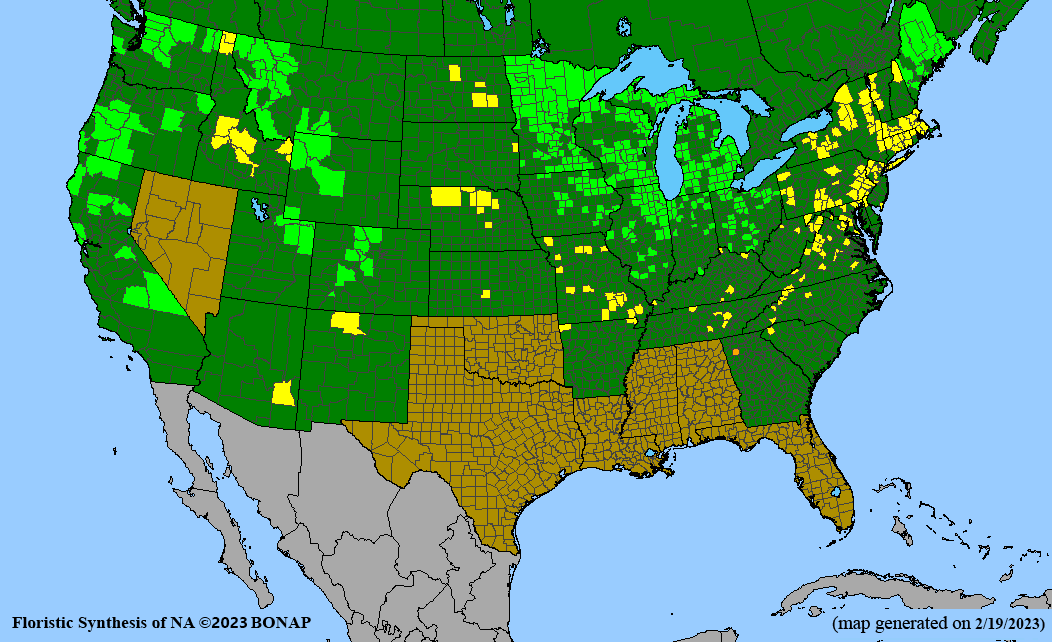
General Comments
Sedges are a large, diverse group of grass-like plants that are important components of prairies, wetlands, and woodlands across our region. In Iowa alone, there are about 120 species of sedges. Grasshoppers and the larvae of skippers and other butterflies and moths feed on wetland sedge foliage, and their seeds are eaten by waterfowl and other birds. Sedges are notoriously difficult to identify to species. Buxbaum’s sedge is distinguishable by, among other characteristics, its rhizomatous habit, bluish green foliage, and dark purplish-brown scales in the seedheads (spikelets). The development of stock seed by the Tallgrass Prairie Center in the early 2000s enabled broader access to reliably identified sedge species by native seed growers. As an obligate wetland species, Buxbaum’s sedge benefits from irrigation in production settings.
Recommendations for Seed Production
- Establishment for seed production
Direct seeding
We do not have experience with direct seeding this species for seed production.
Greenhouse
Seed pre-treatment: Benefits from cold-moist stratification for at least 60 days.
Sowing: Sow in germination flats, covering seed lightly (light improves germination of many sedge species); germination may be slow and sporadic. Daytime temperatures should be around 70-80°F (22-27°C) and allowed to drop at night to 50-60°F (10-15°C). We have had good success dibbling seedlings into 2.5 in deep, 73-cell plug flats that are ridged to direct root development downward and have 3/4 in bottom openings to encourage root pruning and the formation of firmly rooted plugs for transplanting.
Transplanting: Seedlings are ready to transplant to the field about 14-16 weeks after sowing. Pop out a few plugs to check for adequate root development that will provide sturdy plugs for planting. A week or two before transplanting, move flats outside to ‘harden off.’
- Stand management
Weeds: Plastic mulch reduces weed pressure in the first year or more. Plastic must eventually be removed to allow the plants to spread by rhizomes. A well-established stand outcompetes many weeds. In large-scale production systems or those where the use of weed barriers and/or hand weeding is not practical, broad-leaf herbicides and/or pre-emergent herbicides may be useful to prevent weeds from competing with the sedge plants and/or complicating the seed cleaning process. Significant weed problems may be caused by winter annuals (e.g., members of the mustard family), other small-seeded broad-leaf annuals, and annual grasses (e.g., downy brome). Herbicide applications should be timed to most effectively control specific weeds and minimize damage to the sedge plants. Care must be taken to read affected “weed” lists, as sedges are considered weeds in crop systems. Always read and follow label instructions.
Pests: None noted.
Diseases: None noted.
- Seed production
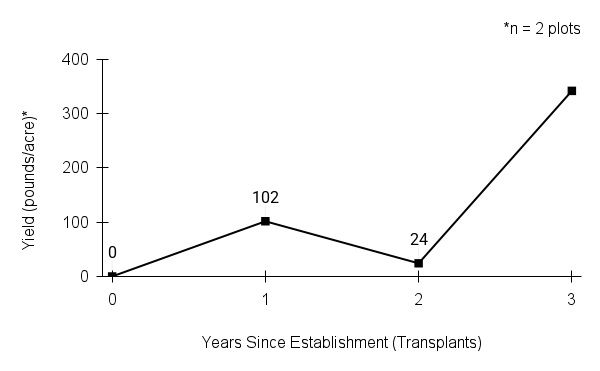 First harvest: Small amounts may be produced in the first and second years after transplanting.
First harvest: Small amounts may be produced in the first and second years after transplanting.Yield/acre: 24-340 lbs per acre
Stand life: Appears to take 3 years to reach peak production; plants are likely long-lived, but uncertain whether yields will be sustained or sporadic; mowing in fall or winter may improve yields in subsequent seasons.
Flowering date: May in northern Iowa
Seed maturity/harvest date: Mid to late June in NE Iowa.
Seed retention: Moderate shattering observed.
Harvest date range at TPC (2010-2011, 2025): June 16 - 27
Recommended harvest method: Combine at maturity; seed threshes cleanly.
- Seed cleaning and storage
Cleaning process: Air-dry combined material for two weeks or more after harvest. Pass material through a coarse screen (1/2 in hardware cloth) to remove larger stemmy material, if needed, then air screen.
Seed storage: Cool/dry (33-50° F, 30-50% RH)
Released Germplasm
Source Identified material: Natural Selections/Iowa Ecotype Zone Iowa
- References
Carex buxbaumii (Buxbaum’s Sedge). Minnesota Wildflowers. (n.d.). https://www.minnesotawildflowers.info/grass-sedge-rush/buxbaums-sedge
Cochrane, T. S., Elliot, K., & Lipke, C. S. (2014). Buxbaum’s Sedge. In Prairie Plants of the University of Wisconsin-Madison Arboretum (3rd ed., p. 161). essay, University of Wisconsin-Madison Arboretum.
Kartesz, J.T., The Biota of North America Program (BONAP). 2023. North American Plant Atlas. (http://bonap.net/napa). Chapel Hill, N.C. [maps generated from Kartesz, J.T. 2023. Floristic Synthesis of North America, Version 1.0. Biota of North America Program (BONAP). (in press)]
Murray, D. F. (2020, November 5). Carex buxbaumii Wahlenberg. Flora of North America. http://floranorthamerica.org/Carex_buxbaumii
NatureServe. 2024. NatureServe Network Biodiversity Location Data accessed through NatureServe Explorer [web application]. NatureServe, Arlington, Virginia. Available https://explorer.natureserve.org/. (Accessed: February 29, 2024).
USDA NRCS National Plant Data Team. (n.d.). Carex buxbaumii Wahlenb.. USDA plants database. https://plants.usda.gov/home/plantProfile?symbol=CABU6
Species Guide Updated 12/2/2024
bottlebrush sedge
bottlebrush sedge dickeye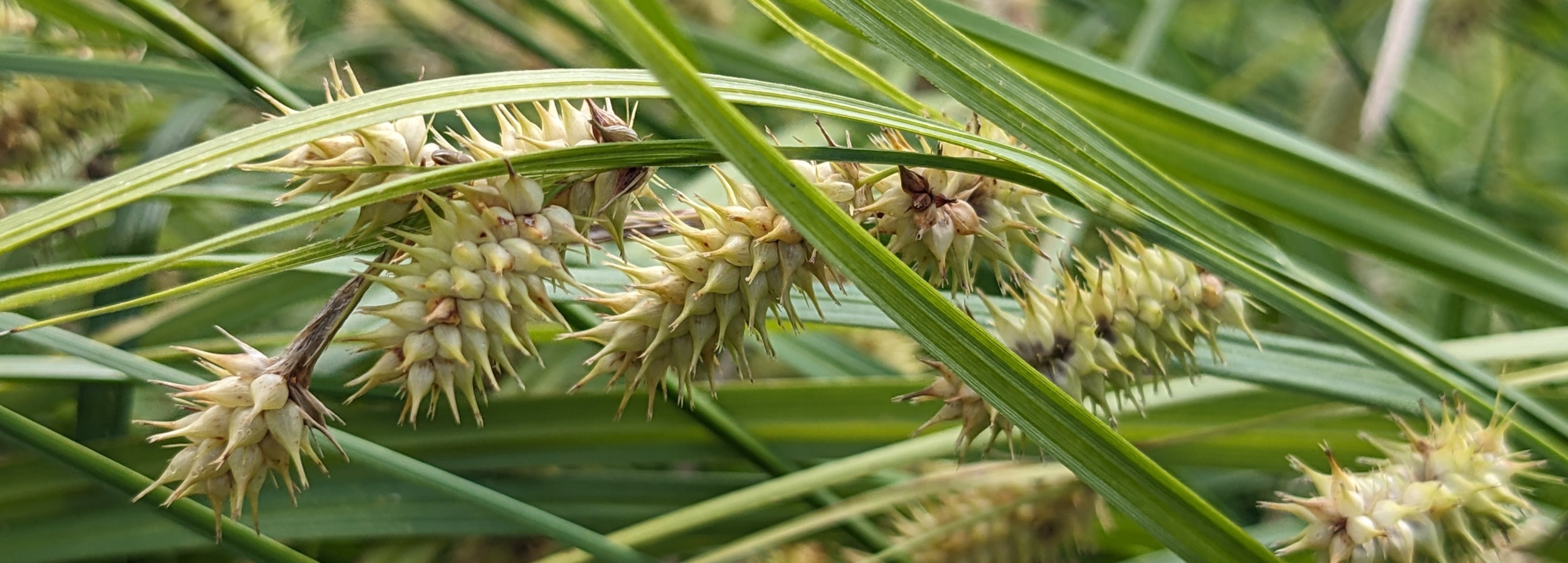
Carex hystericina Muhl. ex Willd.
Alternate Common Name: porcupine sedge
Scientific Synonym: Carex hystricina Muhl. Rydberg.
Family: sedge family (Cyperaceae)
Functional Group: sedges and rushes
Description
- Life cycle and growth form
Perennial with fibrous roots, forms clumps.
Height: 3/4 - 3 ft
- Leaves and stem
Leaves in alternate, 3-ranked arrangement, hairless; basal sheaths are reddish purple and fibrous; culms are stiff and 3-sided, hairless, unbranched.
- Flower, fruit and seedhead
Fruit/seedhead: Seed head consists of a terminal male spike and one to four prickly, cylindrical pistillate spikes, each containing 40-100 perigynia (seed containing structures).
Pollination: wind
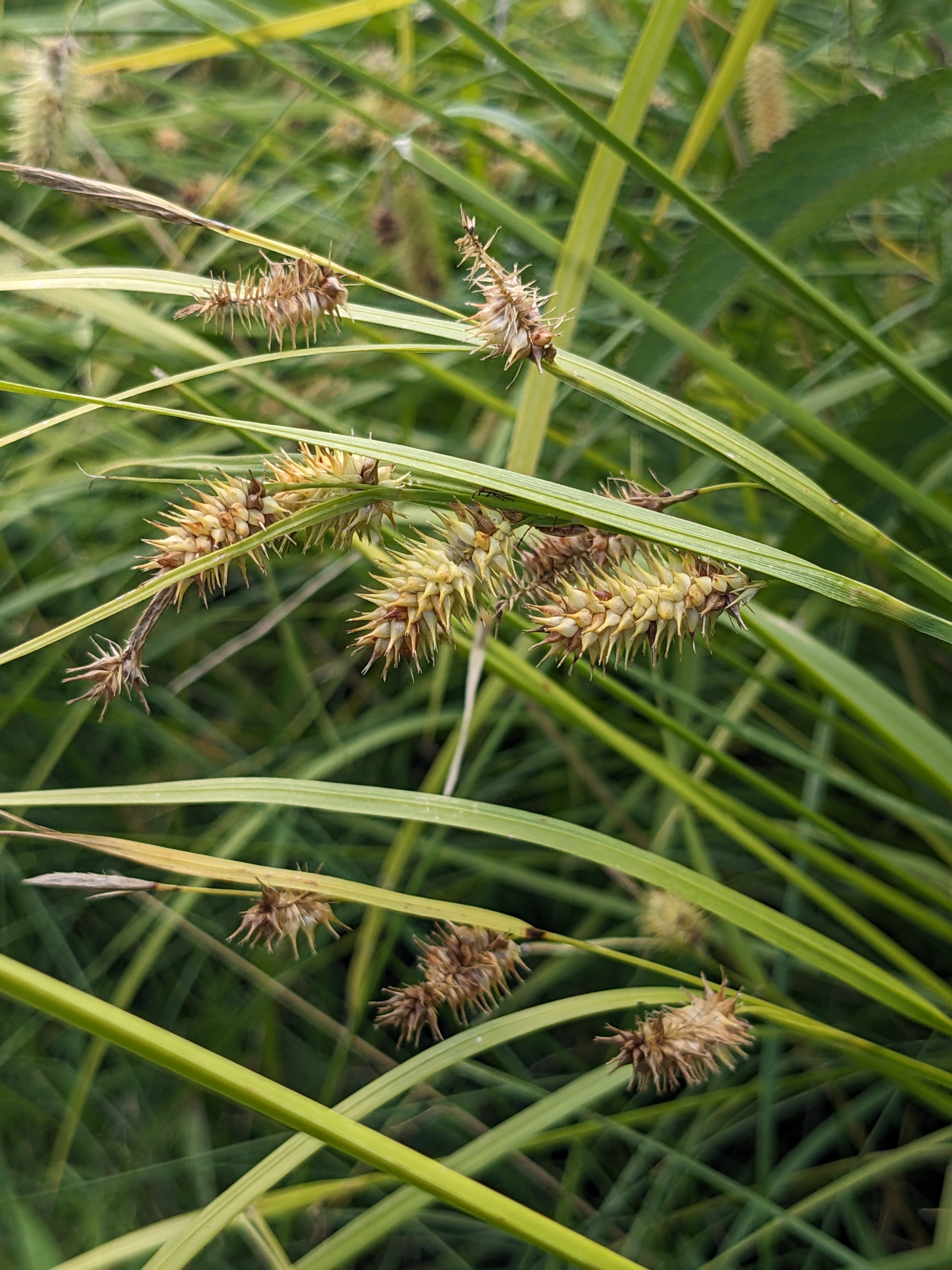
- Seed
Seed characteristics
Seed weight:
Seeds per ounce: 30,000 seeds/oz (IA NRCS)
1000 seed weight: 0.48g (Seed Information Database)
Description: “Seeds” are 3-sided, ovate, brown achenes, wrapped in an inflated, distinctly veined perigynium with a long beak and two short teeth.
Typical seed test
PLS: 87.48% (n=1)
Purity: 99.41% (n=1)
Germination: 62% (n=1)
Dormancy: 26% (n=1, determined by TZ)
(based on one test of a seedlot grown at TPC)
- Habitat and range
Habitat: Moist to wet soil; partial to full sun; prairies, meadows, seeps, fens, marshes, swamps, ditches; Wetland Indicator Status is Obligate Wetland (OBL) for the Midwest.
Conservation status: Global- G5, secure; District of Columbia and Kentucky- SH, possibly extirpated; Maryland- S1, critically imperiled; California and Georgia- S2, imperiled; Arizona, Kansas, Washington, West Virginia, Illinois, and Wyoming- S3, vulnerable (NatureServe)
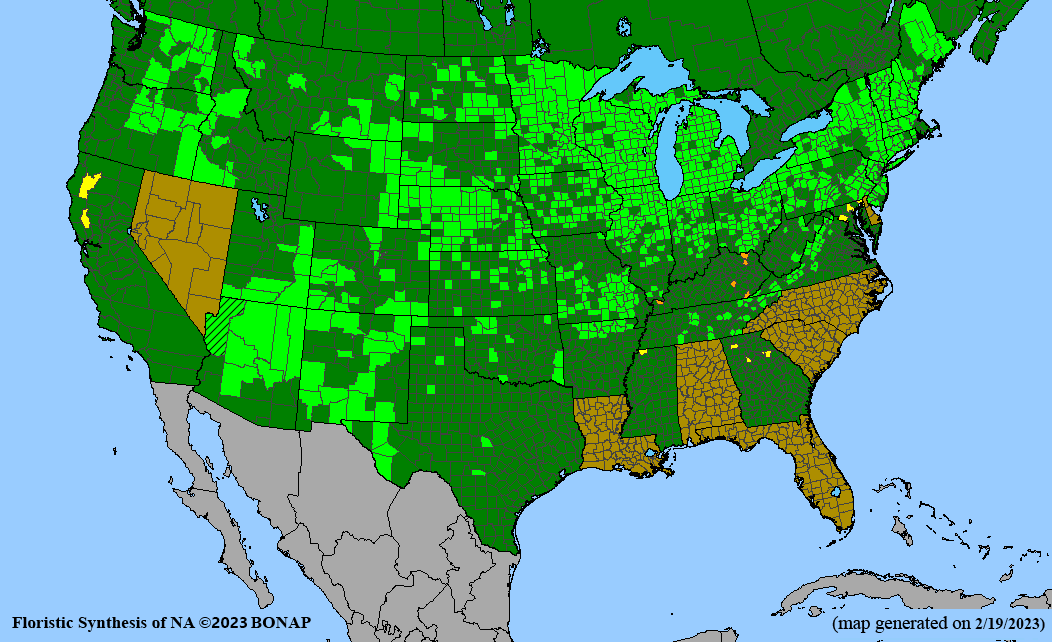
General Comments
Sedges are a large, diverse group of grass-like plants that are important components of prairies, wetlands, and woodlands across our region. In Iowa alone, there are about 120 species of sedges. Grasshoppers and the larvae of skippers and other butterflies and moths feed on wetland sedge foliage, and their seeds are eaten by waterfowl and other birds. Sedges are notoriously difficult to identify to species. The prickly, cylindrical spikes of bottlebrush sedge are somewhat distinctive, but this species can be confused with longhair or bristly sedge (Carex comosa) which also occurs in our region and sallow sedge (Carex lurida) which is a state listed species in Iowa but is more common in neighboring states to the south and east. The development of stock seed by the Tallgrass Prairie Center in the early 2000s enabled broader access to reliably identified sedge species by native seed growers. As an obligate wetland species, bottlebrush sedge benefits from irrigation in production settings.
Recommendations for Seed Production
- Establishment for seed production
Direct seeding
We do not have experience with direct seeding this species for seed production.
Greenhouse
Seed pre-treatment: Benefits from cold-moist stratification for 30 days.
Sowing: Sow in germination flats or directly into plugs (2-3 seeds per cell), covering seed lightly (light improves germination of many sedge species); maintain even moisture until germination. Daytime temperatures should be around 70-80°F (22-27°C) and allowed to drop at night to 50-60°F (10-15°C). We have had good success planting into 2.5 in deep, 73-cell plug flats that are ridged to direct root development downward and have 3/4 in bottom openings to encourage root pruning and the formation of firmly rooted plugs for transplanting.
Transplanting: Seedlings are ready to transplant to the field about 10 weeks after sowing. Pop out a few plugs to check for adequate root development that will provide sturdy plugs for planting. A week or two before transplanting, move flats outside to ‘harden off.’
- Stand management
Weeds: Plastic mulch reduces weed pressure in the first year or more. Holes in the plastic should be widened somewhat in subsequent years to allow the bunches to expand. Bunching plants are robust and leafy, competing well with many weeds; we have interplanted porcupine sedge with wetland forbs to provide support and reduce weed pressure.
Pests: None noted.
Diseases: None noted.
Soil moisture: Irrigation is recommended, though bottlebrush sedge may require less supplemental water than other wetland sedges. Drip tape can be applied under plastic mulch as planting beds are formed.
- Seed production
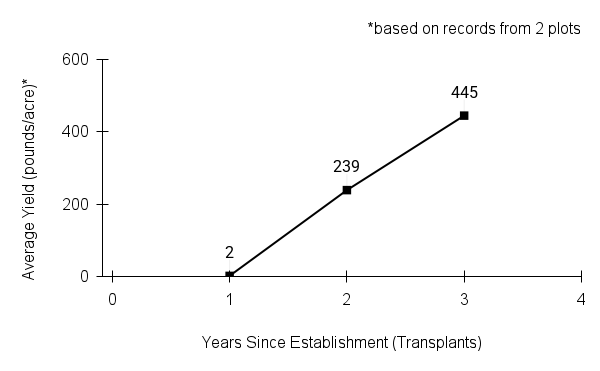
First harvest: Plants produce a small amount of seed in the year following the transplant year. Peak harvest may be in the third year after transplanting.
Yield: At peak (3 years after planting), yields are around 445 lbs per acre (extrapolated from two production plots).
Stand life: Plants may be long-lived, but long-term yields are unknown.
Flowering date: June-July
Seed maturity/harvest date: Early to mid-July in northeast Iowa.
Seed retention: Seed begins to shatter in mid-July.
Harvest date range at TPC (2012-2024): June 26 - July 22
Recommended harvest method: Combine larger plantings. Hand harvest is effective for small plantings, and seed threshes easily from stems once dried.
- Seed cleaning and storage
Cleaning process: Air-dry seed for two weeks or more after harvest. Pass material through a coarse screen (1/2 in hardware cloth) to remove larger stemmy material, if needed, then air screen.
Seed storage: Cool/dry (33-50° F, 30-50% RH)
Released Germplasm
Source Identified material: Natural Selections/Iowa Ecotype Zone IA
- References
Carex hystericina (Porcupine Sedge). Minnesota Wildflowers. (n.d.). https://www.minnesotawildflowers.info/grass-sedge-rush/porcupine-sedge
Eggers, S. D., & Reed, D. M. (1997). Shallow Marshes. In Wetland Plants and Plant Communities of Minnesota and Wisconsin (2nd ed., p. 82). essay, U.S. Army Corps of Engineers, St. Paul District
Great Plains Flora Association. (1991). Sedge Family. In Flora of the Great Plains (2nd ed., p. 1080). University Press of Kansas.
Houseal, G. (2010). Plasticulture for seed production of wetland (Carex) species. Native Plants Journal, 11(1), 58-64. https://doi.org/10.2979/NPJ.2010.11.1.58
Kartesz, J.T., The Biota of North America Program (BONAP). 2023. North American Plant Atlas. (http://bonap.net/napa). Chapel Hill, N.C. [maps generated from Kartesz, J.T. 2023. Floristic Synthesis of North America, Version 1.0. Biota of North America Program (BONAP). (in press)]
Kettenring KM, Gardner G, Galatowitsch SM. Effect of light on seed germination of eight wetland Carex species. Ann Bot. 2006 Oct;98(4):869-74. doi: 10.1093/aob/mcl170. Epub 2006 Aug 11. PMID: 16905568; PMCID: PMC2806167.
Kettering, K.M. & Galatowitsch S.M. (2007) Temperature requirements for dormancy break and seed germination vary greatly among 14 wetland Carex species. Aquatic Botany, 87(3), 209 -220. https://doi.org/10.1016/j.aquabot.2007.06.003
Mohlenbrock, R. H. (1999). Carex hystericina. In Illustrated Flora of Illinois - Sedges: Carex (p. 285). Southern Illinois University Press.
NatureServe. 2024. NatureServe Network Biodiversity Location Data accessed through NatureServe Explorer [web application]. NatureServe, Arlington, Virginia. Available https://explorer.natureserve.org/. (Accessed: February 29, 2024)..
Porcupine Sedge. Illinois Wildflowers. (n.d.). https://www.illinoiswildflowers.info/grasses/plants/porc_sedge.htm
USDA NRCS National Plant Data Team. (n.d.). Carex hystericina Muhl. ex Willd.. USDA plants database. https://plants.usda.gov/home/plantProfile?symbol=CAHY4
Species Guide Updated 12/1/2025
broom sedge
broom sedge dickeye
Carex scoparia Schkuhr ex Willd.
Alternate Common Names: pointed broom sedge, lance-fruited oval sedge
Scientific Synonyms: Carex scoparia Schkuhr var. moniliformis Tuckerm., Carex scoparia Schkuhr var. condensa Fern.
Family: sedge family (Cyperaceae)
Functional Group: sedges and rushes
Description
- Life cycle and growth form
perennial, fibrous rooted, short-rhizomatous, clump forming
Height: 1-2.5 ft
- Leaves and stem
Leaves flat and hairless with rough margins, alternate arrangement, 3-ranked, shorter than flowering stems; top of sheath around flowering stem (culm) has a ‘u’ or ‘v’ shaped notch, basal sheaths are brown and fibrous; culm is hairless and 3-sided, smooth and unbranched.
- Flower, fruit and seedhead
Fruit/seedhead: 3-10 spikes per culm, each up to 2/3 in (10-15 mm) long, often crowded at the end of the culm but still distinct as individual elliptical to oval spikes; golden-tan color at maturity, stem may bend or arch at the tip or be straight.
Pollination: wind
- Seed
Seed characteristics
Seed weight:
Seeds per ounce: 84,000 seeds/oz (IA NRCS)
1000 seed weight: 0.44g (Seed Information Database)
Description: “seed” is an ovate to elliptic, brown achene that is enclosed in a perigynium; perigynium is golden-tan, flat, and hairless, 5-veined on each side, lance-shaped and often 3-4 times as long as wide.
Typical seed test
PLS: 93% (n = 5)
Purity: 96% (n = 5)
Germination: 50% (n = 3)
Dormancy: 66% (n = 5)
(averages obtained from n tests of purchased seed lots)
- Habitat and range
Habitat: Moist to wet soil; partial to full sun; prairies, shorelines, swales, fens, seeps, marshes, ditches; Wetland Indicator Status is Facultative Wetland (FACW) for the Midwest.
Conservation status: Global- G5, secure; North Dakota- SH, possibly extirpated; Arkansas, Utah, and Wyoming- S1, critically imperiled; Montana- S1/S2, critically imperiled to imperiled; Georgia- S3, vulnerable (NatureServe)
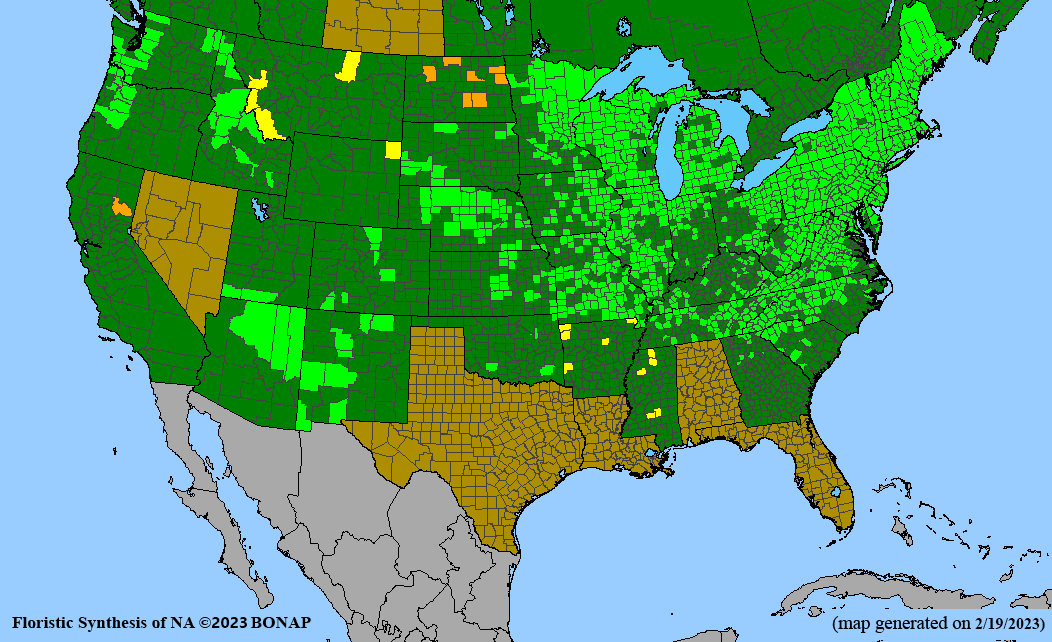
General Comments
Sedges are a large, diverse group of grass-like plants that are important components of prairies, wetlands, and woodlands across our region. In Iowa alone, there are about 120 species of sedges. Grasshoppers and the larvae of skippers and other butterflies and moths feed on sedge foliage, and their seeds are eaten by grassland birds and waterfowl. They are notoriously difficult to identify to species, especially the oval sedges to which broom sedge belongs. The development of stock seed by the Tallgrass Prairie Center in the early 2000s enabled broader access to reliably identified sedge species by native seed growers. Broom sedge is found naturally in moist to wet soils and may benefit from supplemental watering in seed production systems.
Recommendations for Seed Production
- Establishment for seed production
Direct seeding
We do not recommend direct seeding for this species.
Greenhouse
Seed pre-treatment: Benefits from cold-moist stratification for 30 days.
Sowing: Sow in germination flats or directly into plugs (2-3 seeds per cell), covering seed lightly (light improves germination of many sedge species); maintain even moisture until germination. Daytime temperatures should be around 70-80°F (22-27°C) and allowed to drop at night to 50-60°F (10-15°C). We have had good success planting into 2.5 in deep, 73-cell plug flats that are ridged to direct root development downward and have 3/4 in bottom openings to encourage root pruning and the formation of firmly rooted plugs for transplanting.
Transplanting: Seedlings are ready to transplant to an irrigated field about 10 weeks after sowing. Pop out a few plugs to check for adequate root development that will provide sturdy plugs for planting. A week or two before transplanting, move flats outside to ‘harden off.’
- Stand management
Weeds: Plastic mulch reduces weed pressure in the first year or more. Holes in the plastic should be widened somewhat in subsequent years to allow the bunches to expand. Bunching plants are robust and leafy, competing well with many weeds; we have interplanted broom sedge with cardinalflower to provide support and reduce weed pressure (note: interplanting necessitates hand harvest of the sedge and eliminates broadleaf herbicides as an option). In large-scale production systems or those where the use of weed barriers and/or hand weeding is not practical, herbicides (e.g., broad-leaf herbicides and/or pre-emergents) may be useful to prevent weeds from competing with the sedge plants and/or complicating the seed cleaning process. Significant weed problems may be caused by winter annuals (e.g., members of the mustard family), other small-seeded broad-leaf annuals, and annual grasses (e.g., downy brome). Herbicide applications should be timed to most effectively control specific weeds and minimize damage to the sedge plants. Care must be taken to read affected “weed” lists, as sedges are considered weeds in crop systems. Always read and follow label instructions.
Pests: None noted.
Diseases: None noted.
Soil moisture: Irrigation is recommended. Drip tape can be applied under plastic mulch as planting beds are formed.
- Seed production
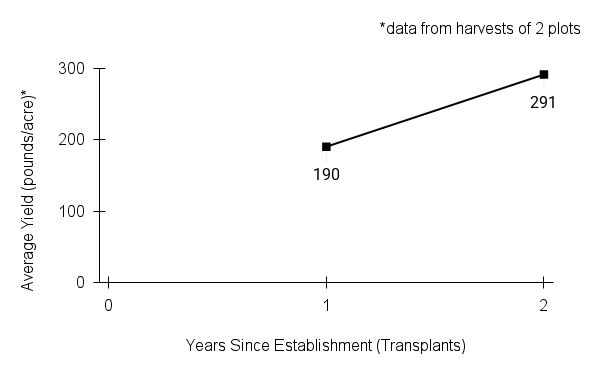 First harvest: First harvest one year after transplanting
First harvest: First harvest one year after transplantingYield/acre: 190-290 pounds per acre (extrapolated from cleaned seed harvested from two plots at TPC)
Stand life: Unknown, but plants are likely long-lived and should continue to be productive with proper weed management.
Flowering date: June
Seed maturity/Harvest date: Late June to early July in northeastern Iowa
Seed retention: Moderate risk of shattering at maturity; also vulnerable to lodging, potentially complicating combine harvest.
Harvest date range at TPC (2010-2023): June 28 - July 3
Recommended harvest method: We have harvested small plots using hand sickles; seed threshes easily after drying on tarps. Combining should also work well, if seed is mature.
- Seed cleaning and storage
Cleaning process: Air-dry seed for two weeks or more after harvest. Pass material through a coarse screen (1/2 in hardware cloth) to remove larger stemmy material, if needed, then air screen.
Seed storage: Cool/dry (33-50° F, 30-50% RH)
Released Germplasm
Source Identified material: Natural Selections/Iowa Ecotype Zone IA
- References
Carex scoparia (Pointed Broom Sedge). Minnesota Wildflowers. (n.d.). https://www.minnesotawildflowers.info/grass-sedge-rush/pointed-broom-sedge
Houseal, G. (2010). Plasticulture for seed production of wetland (Carex) species. Native Plants Journal, 11(1), 58-64. https://doi.org/10.2979/NPJ.2010.11.1.58
Kartesz, J.T., The Biota of North America Program (BONAP). 2023. North American Plant Atlas. (http://bonap.net/napa). Chapel Hill, N.C. [maps generated from Kartesz, J.T. 2023. Floristic Synthesis of North America, Version 1.0. Biota of North America Program (BONAP). (in press)]
Kettenring and Galatowitsch (2007) https://www.sciencedirect.com/science/article/pii/S030437700700085X
Kettenring KM, Gardner G, Galatowitsch SM. Effect of light on seed germination of eight wetland Carex species. Ann Bot. 2006 Oct;98(4):869-74. doi: 10.1093/aob/mcl170. Epub 2006 Aug 11. PMID: 16905568; PMCID: PMC2806167.
Mohlenbrock, R. H. (1999). Carex scoparia. In Illustrated Flora of Illinois - Sedges: Carex (p. 108). Southern Illinois University Press.
Murphy, M. & Spyreas, G. & Marcum, P. (2025) Carex of Illinois & Surrounding States: The Oval Sedges. University of Illinois Press
NatureServe. 2024. NatureServe Network Biodiversity Location Data accessed through NatureServe Explorer [web application]. NatureServe, Arlington, Virginia. Available https://explorer.natureserve.org/. (Accessed: February 29, 2024).
Pointed Broom Sedge. Illinois Wildflowers. (n.d.). https://www.illinoiswildflowers.info/grasses/plants/pb_sedge.htm
USDA NRCS National Plant Data Team. (n.d.). Carex scoparia Schkuhr ex Willd.. USDA plants database. https://plants.usda.gov/home/plantProfile?symbol=CASC11
Species Guide Updated 2/7/2025
